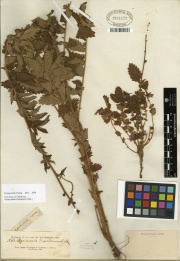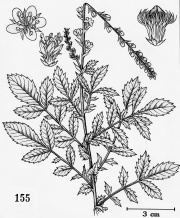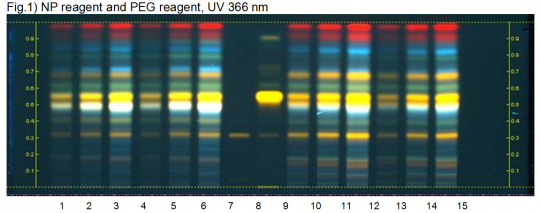Agrimonia eupatoria (flowering tops)
Contents |
Introduction
Macroscopic Entries
{{Macroscopy | source=United States Dispensatory (1918) | description=[Agrimonia eupatoria]'s stem, which rises from one to three feet in height, is hairy, furnished with interruptedly pinnate leaves, and terminated by a long simple spike of yellow flower. It also contains a bitter principle.
|
|
Microscopic Entries
HPTLC Entries
|
Agrimony herb (flowering tops) (Agrimonia eupatoria) Lane Assignments Lanes, from left to right (Track, Volume, Sample):
Reference Sample(s) Reference: Dissolve 5 mg of rutin and 3 mg of isoquercitrin individually in 10 mL of methanol. Stationary Phase Stationary phase, i.e. Silica gel 60, F254 Mobile Phase Ethyl acetate, formic acid 98%, water, ethyl methyl ketone 50:10:10:30 (v/v/v/v) Sample Preparation Method Sample: Mix 1 g of powdered sample with 10 mL of methanol and sonicate for 10 minutes, then centrifuge or filter the solutions and use the supernatants / filtrates as test solutions. Derivatization reagent: 1.) NP reagent, Preparation: 1 g of natural products reagent in 200 mL ethyl acetate; 2.) PEG reagent, Preparation: 10 g of polyethylene glycol 400 in 200 mL methylene chloride, Use: Heat plate 3 min at 100 °C, dip (time 0, speed 5) in NP reagent, dry and dip (time 0, speed 5) in PEG reagent. Detection Method Saturated chamber; developing distance 70 mm from lower edge; relative humidity 33% Other Notes Images presented in this entry are examples and are not intended to be used as basis for setting specifications for quality control purposes. System suitability test: Rutin: yellow fluorescent zone at Rf ~ 0.32; Isoquercitrin: yellow fluorescent zone at Rf ~ 0.55 Identification: Compare result under UV 366 nm with reference images. The fingerprint of the test solution is similar to that of the corresponding botanical reference sample. Additional weak zones may be present. The chromatogram of the test solution shows a yellow zone at the position of rutin. At the position of isoquercitrin a yellow zone is seen together with a white zone just below as well as a green fluorescent zone and another yellow fluorescent zone just above. Close to the solvent front two red zones above a blue zone are seen. (NOTE: The Ph. Eur. 6.7 monograph lists 4 orange yellow zones).
|
Other Points of Interest
Cite error: <ref> tags exist, but no <references/> tag was found


